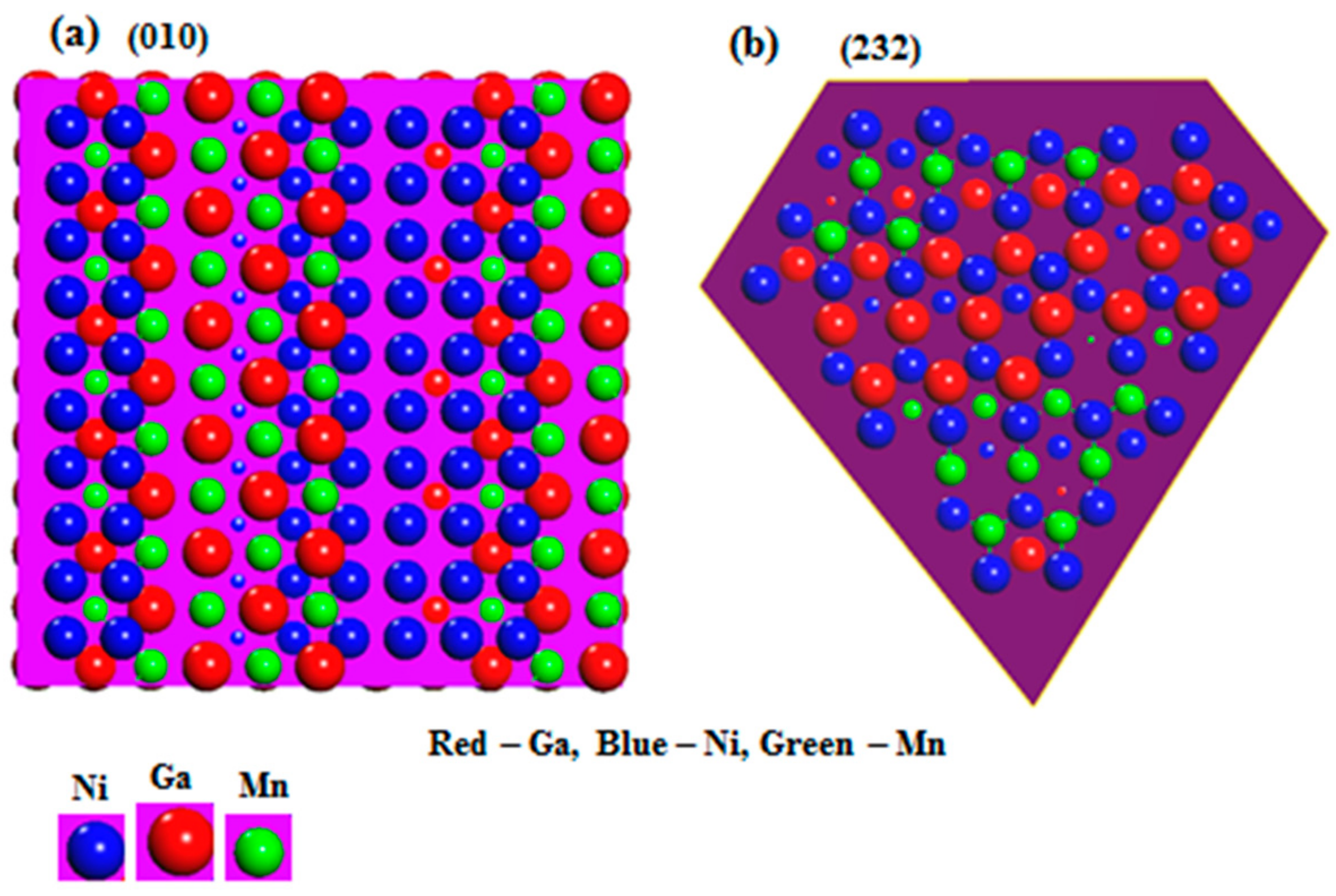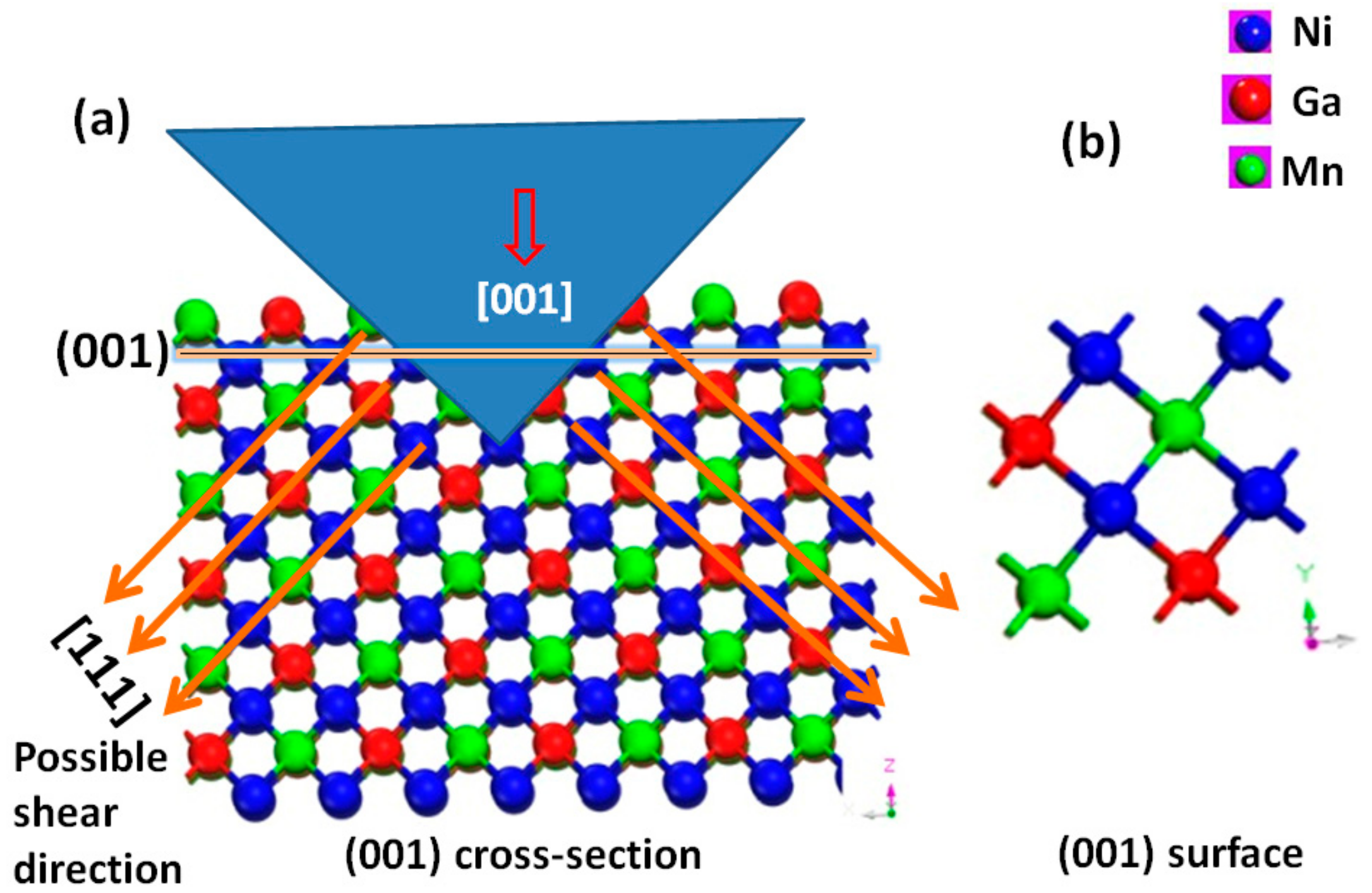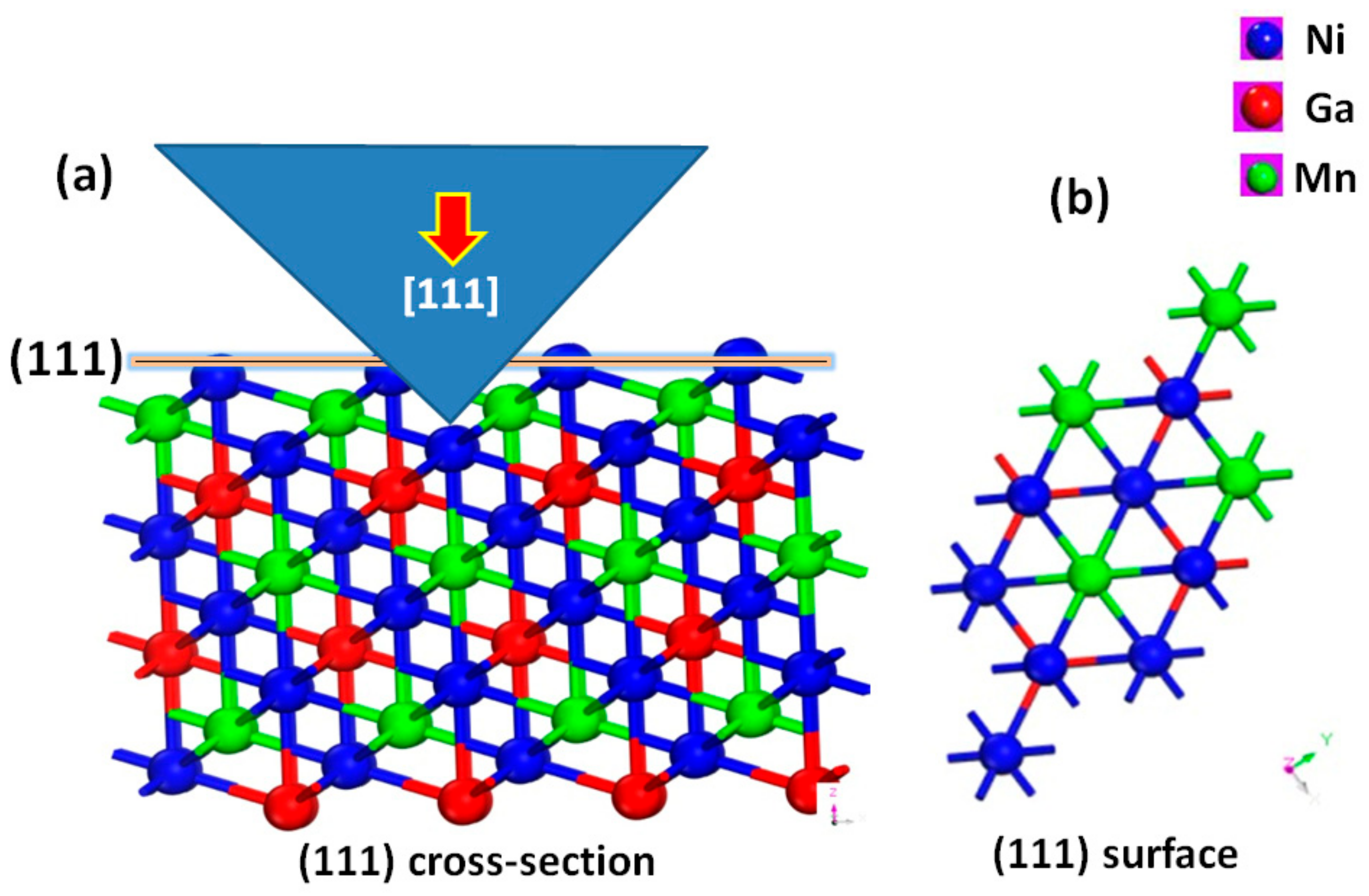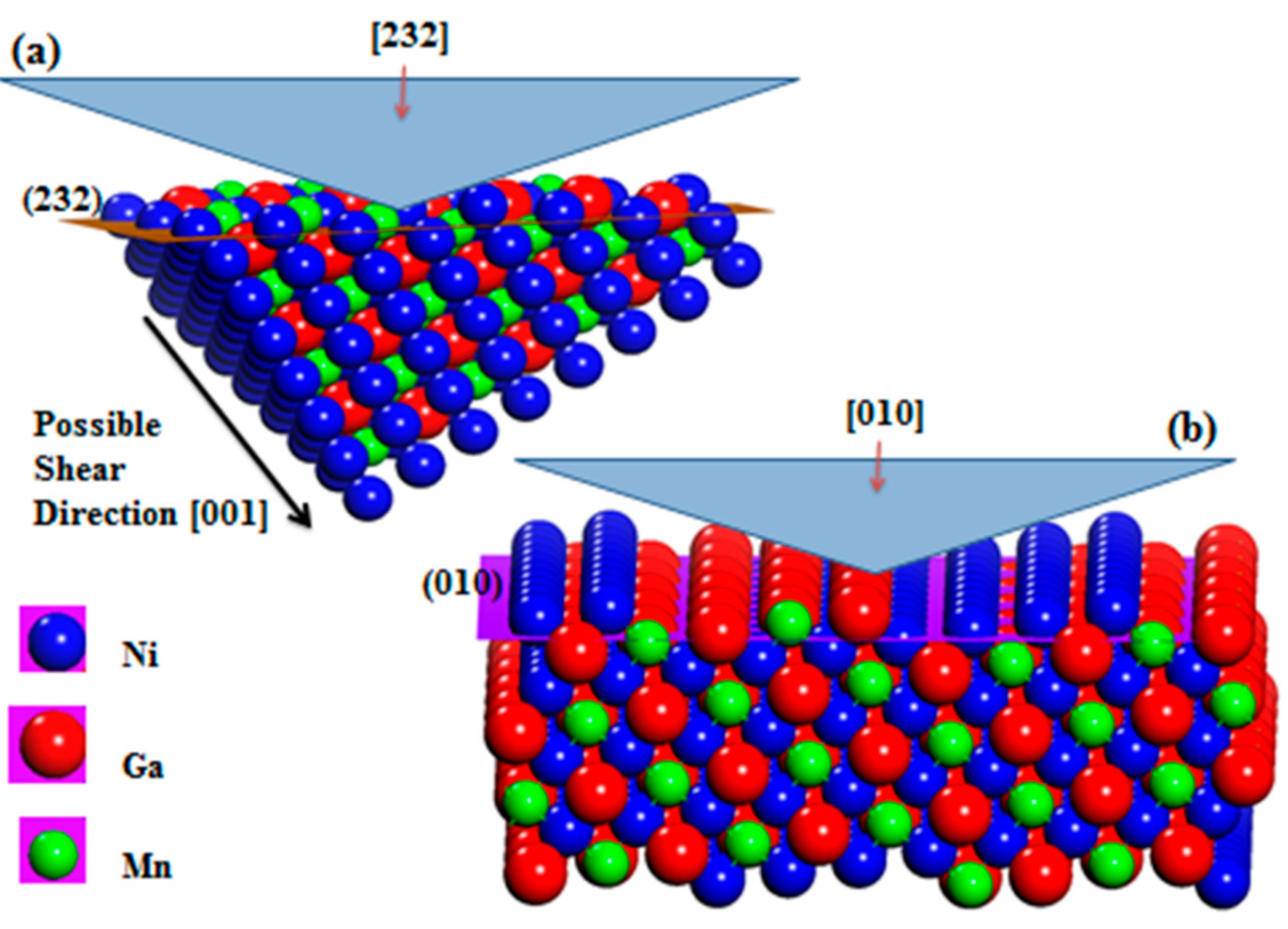Mechanical Anisotropy in Austenitic NiMnGa Alloy: Nanoindentation Studies
Abstract
:1. Introduction
2. Experimental
3. Results and Discussion
4. Conclusions
Supplementary Materials
Acknowledgments
Author Contributions
Conflicts of Interest
References
- Pasquale, M. Mechanical sensors and actuators. Sens. Actuators A Phys. 2003, 106, 142–148. [Google Scholar] [CrossRef]
- Suorsa, I.; Tellinen, J.; Ullakko, K.; Pagounis, E. Voltage generation induced by mechanical straining in magnetic shape memory materials. J. Appl. Phys. 2004, 95, 8054–8058. [Google Scholar] [CrossRef]
- Ham-Su, R.; Healey, J.P.; Underhill, R.S.; Farrell, S.P.; Cheng, L.M.; Hyatt, C.V. Fabrication of magnetic shape memory alloy/polymer composites. Proc. SPIE 2005, 5761, 490–500. [Google Scholar]
- Chen, F.; Cai, W.; Zhao, L.; Zheng, Y.F. Mechanical Properties and Fracture Analysis of Mn-Rich Ni-Mn-Ga Polycrystalline Alloys. Key Eng. Mater. 2006, 325, 691–694. [Google Scholar] [CrossRef]
- Manosa, L.; Comas, A.G.; Obrado, E.; Planes, A.; Chernenko, V.A.; Kokorin, V.V.; Cesari, E. Anomalies related to the TA 2-phonon-mode condensation in the Heusler Ni2MnGa alloy. Phys. Rev. B 1997, 55, 11068–11071. [Google Scholar] [CrossRef] [Green Version]
- Wuttig, M.; Liu, L.; Tsuchiya, K.; James, R.D. Occurrence of ferromagnetic shape memory alloys. J. Appl. Phys. 2000, 87, 4707–4711. [Google Scholar] [CrossRef]
- Worgull, J.; Petti, E.; Trivisonno, J. Behavior of the elastic properties near an intermediate phase transition in Ni2MnGa. Phys. Rev. B 1996, 54, 15695–15699. [Google Scholar] [CrossRef]
- MacLaren, J.M. Role of alloying on the shape memory effect in Ni2MnGa. J. Appl. Phys. 2002, 91, 7801–7803. [Google Scholar] [CrossRef]
- Zhou, L.; Giri, A.; Cho, K.; Sohn, Y. Mechanical anomaly observed in Ni-Mn-Ga alloys by nanoindentation. Acta Mater. 2016, 118, 54–63. [Google Scholar] [CrossRef]
- Jakob, A.M.; Müller, M.; Rauschenbach, B.; Mayr, S.G. Nanoscale mechanical surface properties of single crystalline martensitic Ni-Mn-Ga ferromagnetic shape memory alloys. New J. Phys. 2012, 14, 033029. [Google Scholar] [CrossRef]
- Kiran, M.S.R.N.; Varughese, S.; Reddy, C.M.; Ramamurty, U.; Desiraju, G.R. Mechanical anisotropy in crystalline saccharin: Nanoindentation studies. Cryst. Growth Des. 2010, 10, 4650–4655. [Google Scholar] [CrossRef]
- Viswanath, B.; Raghavan, R.; Ramamurty, U.; Ravishankar, N. Mechanical properties and anisotropy in hydroxyapatite single crystals. Scripta Mater. 2007, 57, 361–364. [Google Scholar] [CrossRef]
- Gollapudi, S.; Azeem, M.A.; Tewari, A.; Ramamurty, U. Orientation dependence of the indentation impression morphology in a Mg alloy. Scripta Mater. 2011, 64, 189–192. [Google Scholar] [CrossRef]
- Kumar, A.; Rabe, U.; Hirsekorn, S.; Arnold, W. Elasticity mapping of precipitates in polycrystalline materials using atomic force acoustic microscopy. Appl. Phys. Lett. 2008, 92, 183106. [Google Scholar] [CrossRef]
- Vlassak, J.J.; Nix, W.D. Measuring the elastic properties of anisotropic materials by means of indentation experiments. J. Mech. Phys. Solids 1994, 42, 1223–1245. [Google Scholar] [CrossRef]
- Vlassak, J.J.; Nix, W.D. Indentation modulus of elastically anisotropic half spaces. Philos. Mag. A 1993, 67, 1045–1056. [Google Scholar] [CrossRef]
- Oliver, W.C.; Pharr, G.M. An improved technique for determining hardness and elastic modulus using load and displacement sensing indentation experiments. J. Mater. Res. 1992, 7, 1564–1583. [Google Scholar] [CrossRef]
- Varughese, S.; Kiran, M.S.R.N.; Ramamurty, U.; Desiraju, G.R. Nanoindentation in crystal engineering: Quantifying mechanical properties of molecular crystals. Angew. Chem. Int. Ed. 2013, 52, 2701–2712. [Google Scholar] [CrossRef] [PubMed]
- Kiran, M.S.R.N.; Varughese, S.; Ramamurty, U.; Desiraju, G.R. Effect of dehydration on the mechanical properties of sodium saccharin dihydrate probed with nanoindentation. CrystEngComm 2012, 14, 2489–2493. [Google Scholar] [CrossRef]
- Mishra, M.K.; Varughese, S.; Ramamurty, U.; Desiraju, G.R. Odd–even effect in the elastic modulii of α, ω-alkanedicarboxylic acids. J. Am. Chem. Soc. 2013, 135, 8121–8124. [Google Scholar] [CrossRef] [PubMed]
- Mishra, M.K.; Desiraju, G.R.; Ramamurty, U.; Bond, A.D. Studying microstructure in molecular crystals with nanoindentation: Intergrowth polymorphism in Felodipine. Angew. Chem. Int. Ed. 2014, 53, 13102–13105. [Google Scholar] [CrossRef]
- Sanphui, P.; Mishra, M.K.; Ramamurty, U.; Desiraju, G.R. Tuning mechanical properties of pharmaceutical crystals with multicomponent crystals: Voriconazole as a case study. Mol. Pharm. 2015, 12, 889–897. [Google Scholar] [CrossRef]
- Krishna, G.R.; Kiran, M.S.R.N.; Fraser, C.L.; Ramamurty, U.; Reddy, C.M. The Relationship of Solid-State Plasticity to Mechanochromic Luminescence in Difluoroboron Avobenzone Polymorphs. Adv. Funct. Mater. 2013, 23, 1422–1430. [Google Scholar] [CrossRef]
- Ghosh, S.; Mondal, A.; Kiran, M.S.R.N.; Ramamurty, U.; Reddy, C.M. The role of weak interactions in the phase transition and distinct mechanical behavior of two structurally similar caffeine co-crystal polymorphs studied by nanoindentation. Cryst. Growth Des. 2013, 13, 4435–4441. [Google Scholar] [CrossRef]
- Spencer, E.C.; Kiran, M.S.R.N.; Li, W.; Ramamurty, U.; Ross, N.L.; Cheetham, A.K. Pressure-Induced Bond Rearrangement and Reversible Phase Transformation in a Metal–Organic Framework. Angew. Chem. Int. Ed. 2014, 53, 5583–5586. [Google Scholar] [CrossRef]
- Li, W.; Kiran, M.S.R.N.; Manson, J.L.; Schlueter, J.A.; Thirumurugan, A.; Ramamurty, U.; Cheetham, A.K. Mechanical properties of a metal–organic framework containing hydrogen-bonded bifluoride linkers. Chem. Comm. 2013, 49, 4471–4473. [Google Scholar] [CrossRef]
- Li, W.; Barton, P.T.; Kiran, M.S.R.N.; Burwood, R.P.; Ramamurty, U.; Cheetham, A.K. Magnetic and Mechanical Anisotropy in a Manganese 2-Methylsuccinate Framework Structure. Chemistry 2011, 17, 12429–12436. [Google Scholar] [CrossRef]
- Varughese, S.; Kiran, M.S.R.N.; Ramamurty, U.; Desiraju, G.R. Nanoindentation as a Probe for Mechanically-Induced Molecular Migration in Layered Organic Donor–Acceptor Complexes. Chem. Asian J. 2012, 7, 2118–2125. [Google Scholar] [CrossRef]
- Raut, D.; Kiran, M.S.R.N.; Mishra, M.K.; Asiri, A.M.; Ramamurty, U. On the loading rate sensitivity of plastic deformation in molecular crystals. CrystEngComm 2016, 18, 3551–3555. [Google Scholar] [CrossRef]
- Sontakke, P.; Gupta, A.; Hiwarkar, V.; Krishnan, M.; Samajdar, I. Self-Accommodating Microstructure and Intervariant Interfaces of 5M and NM Martensites in Off-Stoichiometric Ni2MnGa Alloys. In International Conference on Martensitic Transformations (ICOMAT); John Wiley & Sons, Inc.: Hoboken, NJ, USA, 2009. [Google Scholar]
- Otsuka, K.; Wayman, C.M. Shape Memory Materials; Cambridge University Press: Cambridge, UK, 1999. [Google Scholar]
- Crone, W.C.; Brock, H.; Creuziger, A. Nanoindentation and microindentation of CuAlNi shape memory alloy. Exp. Mech. 2007, 147, 133–142. [Google Scholar] [CrossRef]
- Yoo, M.H.; Horton, J.A.; Liu, C.T. Micromechanisms of Deformation and Fracture in Ordered Intermetallic Alloys: 1, Strengthening Mechanisms; [Ni/sub 3/Al and CuZn]; Oak Ridge National Lab.: Oak Ridge, TN, USA, 1988. [Google Scholar]
- Yamaguchi, M.; Umakoshi, Y. Deformation of single crystals of the L2 1 ordered Ag2MgZn. J. Mater. Sci. 1980, 15, 2448–2454. [Google Scholar] [CrossRef]
- Li, T.L.; Gao, Y.F.; Bei, H.; George, E.P. Indentation Schmid factor and orientation dependence of nanoindentation pop-in behavior of NiAl single crystals. J. Phys. Sol. 2011, 59, 1147–1162. [Google Scholar] [CrossRef]
- Haušild, P.; Materna, A.; Nohava, J. Characterization of anisotropy in hardness and indentation modulus by nanoindentation. Metallogr. Microstruct. Anal. 2014, 3, 5–10. [Google Scholar] [CrossRef]
- Patel, D.K.; Al-Harbi, H.F.; Kalidindi, S.R. Extracting single-crystal elastic constants from polycrystalline samples using spherical nanoindentation and orientation measurements. Acta Mater. 2014, 79, 108–116. [Google Scholar] [CrossRef]






| Color Scheme | Φ1 (Degrees) | Φ (Degrees) | Φ2 (Degrees) | Plane |
|---|---|---|---|---|
| Purple | 138.8 | 65.1 | 203.9 | 3.45° from |
| Cream | 277.2 | 82.1 | 333.2 | 6.4° from |
| Orange | 254.8 | 99.5 | 179.4 | 8.1° from |
| Blue | 47.3 | 58.3 | 32.8 | 2.9° from |
| Pink | 63 | 104 | 33.4 | 5.3° from |
| Direction | Slip System | Maximum Schmid Factor | hmax (nm) | Hardness, H (GPa) | Reduced Modulus, Er (GPa) |
|---|---|---|---|---|---|
| [] | 001> | 0.09 | 326 | 3.7 ± 0.04 | 81 ± 0.7 |
| [] | 0.34 | 344 | 3.39 ± 0.05 | 69.2 ± 0.7 | |
| [] | 0.36 | 346 | 3.3 ± 0.04 | 70.2 ± 0.7 | |
| [] | 0.45 | 360 | 3.2 ± 0.03 | 64.8 ± 0.6 | |
| [] | 0.49 | 377 | 2.9 ± 0.06 | 58.9 ± 0.8 |
| Material | EMhighest (GPa) | EMlowest (GPa) | Elastic Anisotropy Factor (EMhighest/EMlowest) | Space Group |
|---|---|---|---|---|
| W | 439 | 438 | 1.002 | |
| Al | 79 | 77 | 1.025 | |
| Cu | 137 | 124 | 1.104 | |
| Brass | 130 | 104 | 1.250 | |
| Ni-Mn-Ga | 86.68 * | 65.83 * | 1.31 |
© 2017 by the authors. Licensee MDPI, Basel, Switzerland. This article is an open access article distributed under the terms and conditions of the Creative Commons Attribution (CC BY) license (http://creativecommons.org/licenses/by/4.0/).
Share and Cite
Jayaraman, A.; Kiran, M.S.R.N.; Ramamurty, U. Mechanical Anisotropy in Austenitic NiMnGa Alloy: Nanoindentation Studies. Crystals 2017, 7, 254. https://doi.org/10.3390/cryst7080254
Jayaraman A, Kiran MSRN, Ramamurty U. Mechanical Anisotropy in Austenitic NiMnGa Alloy: Nanoindentation Studies. Crystals. 2017; 7(8):254. https://doi.org/10.3390/cryst7080254
Chicago/Turabian StyleJayaraman, Ashwin, M. S. R. N. Kiran, and Upadrasta Ramamurty. 2017. "Mechanical Anisotropy in Austenitic NiMnGa Alloy: Nanoindentation Studies" Crystals 7, no. 8: 254. https://doi.org/10.3390/cryst7080254





